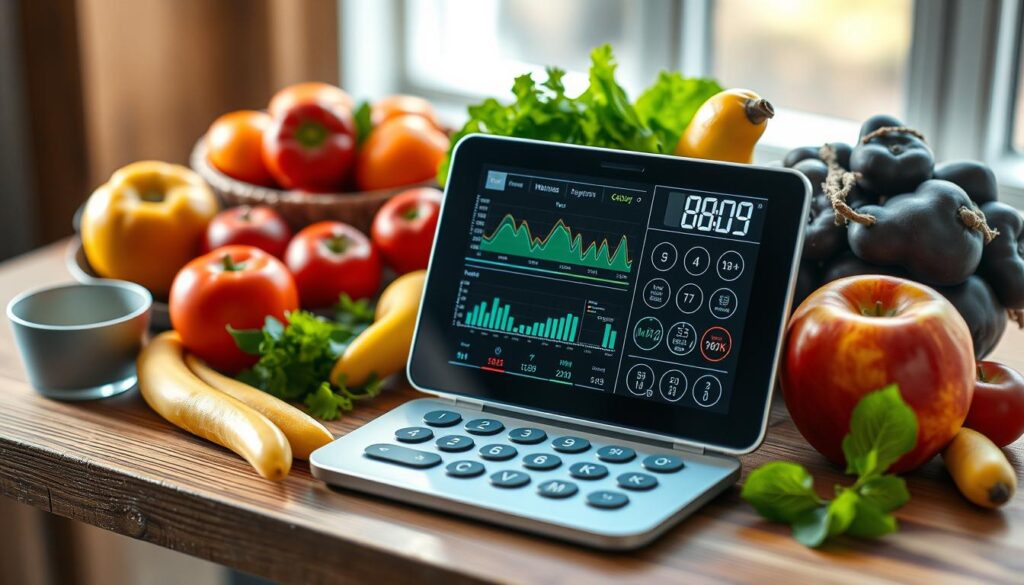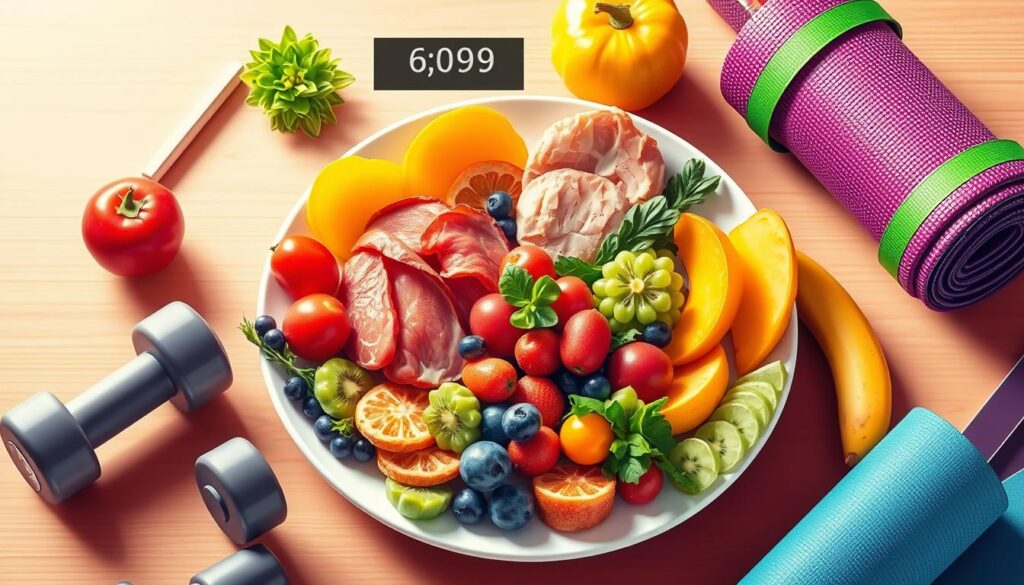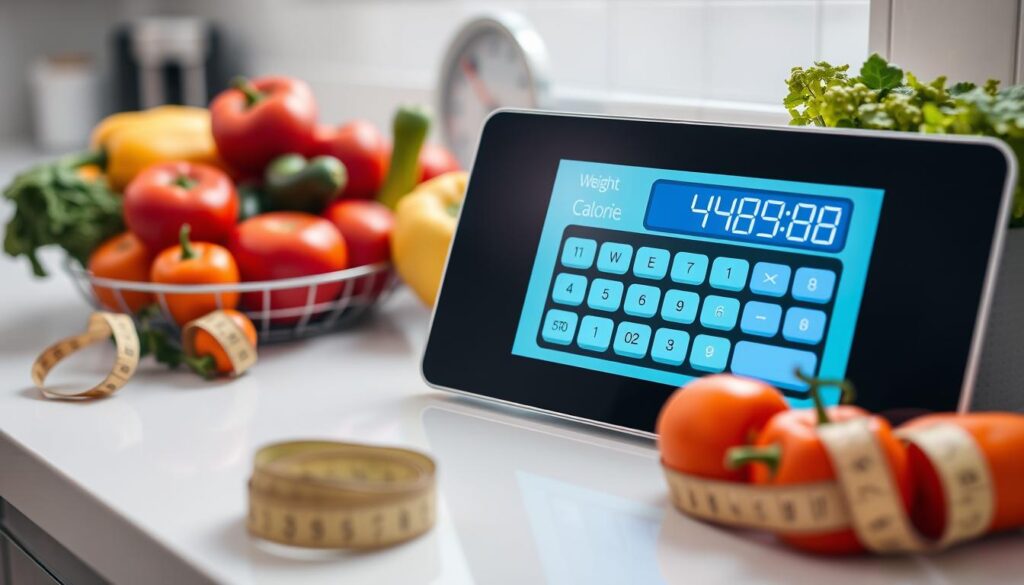Using a to lose weight calorie calculator can help you reach your weight loss goals. These tools figure out how many calories you need each day. They look at your age, gender, height, weight, and how active you are.
They help you find out how many calories your body burns when you’re not moving. This is called your Basal Metabolic Rate (BMR). Knowing this lets you make a plan to eat fewer calories to lose weight.
Key Takeaways
- Calorie calculators estimate your daily calorie needs based on factors like age, gender, height, weight, and activity level.
- These calculators use equations such as Mifflin-St Jeor, Revised Harris-Benedict, and Katch-McArdle to determine your Basal Metabolic Rate (BMR).
- Understanding your BMR and Resting Daily Energy Expenditure (RDEE) helps you create a calorie deficit plan for weight loss.
- Calorie calculators provide a personalized estimate of your daily calorie requirements for weight maintenance, loss, or gain.
- Utilizing a to lose weight calorie calculator can be a valuable tool in your weight loss journey.
Understanding Basal Metabolic Rate and Daily Energy Needs
Learning about your Basal Metabolic Rate (BMR) and Total Daily Energy Expenditure (TDEE) is key. BMR is how much energy your body needs when you’re resting. TDEE includes your activity level to show your daily calorie needs.
What is BMR and Why It Matters
Your BMR is like your body’s energy use when you’re not moving. It’s about 70% of your daily energy use. The BMR calculator uses special formulas to find your BMR.
Factors Affecting Your Daily Calorie Needs
Many things affect how many calories you need each day. These include your age, sex, height, weight, and how active you are. Even the weather can change your BMR.
The Role of Physical Activity in Calorie Requirements
How active you are also matters a lot. Doing exercises like weight-lifting can make your BMR higher. This is because you’re building muscle, which uses more energy when you’re not moving.
Knowing about BMR and TDEE helps you set good weight loss goals. It lets you make plans that fit your body and life. Using BMR and TDEE calculators is a big step towards your health goals.
Getting Started with to lose weight calorie calculator
Starting a weight loss journey is both exciting and scary. A key tool is the weight loss calorie calculator. This helps find the right calorie deficit for losing weight safely and steadily.
When using a weight loss calorie calculator, setting realistic goals is key. Don’t aim for too few calories. Women should aim for 1,200-1,300 calories a day. Men should aim for 1,400-1,500 calories.
Going below these numbers can cause nutrient deficiencies and muscle loss. It can also slow down your metabolism.
To get the best results, enter your info correctly. This includes your age, height, gender, and how active you are. This way, the calculator can give you a calorie target that fits your needs and lifestyle.
Remember, the goal is to lose weight slowly and safely. This keeps your health and well-being in check.
Using a weight loss calorie calculator makes your journey easier. It helps you avoid guessing and sets you up for success. Just remember to eat well and stay active too. This will help you reach your weight goals.
Essential Components for Accurate Calorie Calculations
To lose weight or keep it off, you need to know how many calories you should eat. This depends on your age, gender, height, weight, and how active you are.
Age and Gender Considerations
As you get older, your body burns fewer calories at rest. This is because you lose muscle and your hormones change. Gender also matters, as men usually burn more calories than women because of their body type.
Height and Weight Measurements
It’s very important to know your height and weight accurately. Your body’s shape and how much muscle you have also affect how many calories you need. So, give the calculator the right numbers.
Activity Level Assessment
How active you are every day affects how many calories you burn. The calculator will ask you to choose how active you are. Don’t guess too low or you might not reach your calorie goal.
| Activity Level | Activity Factor |
|---|---|
| Sedentary | 1.2 |
| Lightly Active | 1.375 |
| Moderately Active | 1.55 |
| Very Active | 1.725 |
| Extremely Active | 1.9 |
When you enter your age, gender, height, weight, and activity level, the calculator can tell you how many calories you need. This is helpful for macro tracking, intermittent fasting, keto diet, or any other weight loss or fitness goals.
Setting Realistic Weight Loss Goals
Starting a weight loss diet means setting goals that fit your health and what you want. Losing 1-2 pounds a week is a good pace. This means you need to eat 500-1,000 calories less each day.
To find your ideal weight, use a BMI calculator. It gives a starting point. But remember, BMI doesn’t tell everything. Your body’s makeup and health matter too when setting weight loss goals.
The goal is more than just losing weight. It’s about living a balanced, healthy life. Setting realistic goals helps you succeed and keep your weight off for good.
| Metric | Recommended Range |
|---|---|
| Healthy BMI | 18.5 – 24.9 |
| Healthy Weight Loss Rate | 1-2 pounds per week |
| Calorie Deficit for Weight Loss | 500-1,000 calories per day |

For successful weight loss, focus on balance. Think about your health, lifestyle, and long-term goals. Setting realistic goals and making lasting changes will help you reach your goals.
Understanding Macronutrient Ratios for Weight Loss
For effective weight loss, knowing the right mix of macronutrients is key. These are protein, carbs, and fats. The weight loss calculator gives daily values for these based on your body, activity, and goals.
Protein Requirements for Fat Loss
Enough protein is vital to keep muscle while losing weight. The calculator suggests 1-1.2 grams of protein per kilogram of body weight for those who don’t move much. For the active, it’s 1.4-2.2 grams per kilogram. This helps you keep lean muscle while losing fat.
Balancing Carbohydrates and Fats
The best mix for losing fat and gaining muscle is about 40% protein, 30% carbs, and 30% fats. This mix helps you lose weight, gives energy, and keeps you healthy.
Optimal Macro Distribution
The calculator uses your BMR and activity level to figure out your calorie needs. It then suggests a mix of 40% protein, 30% carbs, and 30% fats. You can adjust this based on your likes and goals. This careful tracking helps you get the most out of a low-carb diet and boosts your protein intake for macro tracking.
| Macronutrient | Grams per Day (1800 calories) | Calories per Gram | Calories per Day | Percentage of Total Calories |
|---|---|---|---|---|
| Protein | 180g | 4 | 720 | 40% |
| Carbohydrates | 135g | 4 | 540 | 30% |
| Fats | 60g | 9 | 540 | 30% |
“Tracking your daily macros is essential for reaching your weight loss or muscle gain goals. The right balance of protein, carbs, and fats can make all the difference.”
Creating Your Calorie Deficit Strategy
To lose weight in a healthy way, you need a plan for fewer calories. This means eating less than your body uses. Aim for a 500-1,000 calorie cut each day. This will help you lose 1-2 pounds weekly, a good pace.
To start, find out how many calories you burn daily. This is called your total daily energy expenditure (TDEE). Use your basal metabolic rate (BMR) and activity level to figure this out. Then, lower your calorie goal by 20% to make a deficit.
- Calculate your TDEE: Use an online calculator or the BMR formulas to find your daily calorie needs.
- Set your calorie target: Lower your TDEE by 20% to get your daily calorie goal. For example, if your TDEE is 2,500 calories, aim for 2,000 calories daily.
- Focus on nutrient-dense, low-calorie foods: Eat more fruits, veggies, lean proteins, and whole grains. They help you feel full and happy while eating less.
- Incorporate regular physical activity: Adding more exercise to your diet can help you lose fat faster.
Don’t make your calorie deficit too big. It should be big enough to help you lose weight but not so big it hurts your health. Aim for a slow, steady weight loss for the best results.
“The key to successful weight loss is creating a calorie deficit that you can stick to in the long-term, not a quick fix that leaves you feeling deprived and frustrated.”

| Calorie Deficit | Estimated Weight Loss per Week |
|---|---|
| 500 calories | 1 pound |
| 1,000 calories | 2 pounds |
Common Foods and Their Caloric Values
Knowing how many calories are in foods we eat every day is key. It helps us count calories and manage our weight. Whether you want to lose weight, keep your weight the same, or get fit, knowing food calories helps you make better choices.
Protein Sources and Calorie Content
Lean proteins like chicken breast (165 calories per 3.5 oz) and salmon (206 calories per 3.5 oz) are great for your diet. They give you important nutrients without too many calories.
Smart Carbohydrate Choices
Choose carbs that are full of nutrients, like fruits (e.g., apple: 95 calories, banana: 105 calories) and whole grains (e.g., quinoa: 222 calories per cup cooked, brown rice: 216 calories per cup cooked). These foods are good for you and keep your calorie count right.
Healthy Fat Options
Healthy fats are good for a balanced diet. Foods like avocado (114 calories per half) and olive oil (119 calories per tablespoon) are healthy and low in calories. Eat them in small amounts to get their benefits.
Counting calories is just part of the battle. It’s also about eating foods that are good for you. Knowing the calories in common foods helps you make choices that are healthy and support your goals.
| Food Item | Calories per Serving |
|---|---|
| Apple (medium) | 95 calories |
| Banana (medium) | 105 calories |
| Grapes (1 cup) | 52 calories |
| Orange (medium) | 62 calories |
| Strawberries (1 cup) | 49 calories |
| Chicken Breast (3.5 oz, cooked) | 165 calories |
| Salmon (3.5 oz, cooked) | 206 calories |
| Avocado (half) | 114 calories |
| Olive Oil (1 tablespoon) | 119 calories |
Tracking Progress and Making Adjustments
It’s important to watch your weight loss journey closely. Use tools like the weight loss calculator, BMI calculator, and body fat calculator to help. They can guide you in adjusting your diet and exercise.
Start by weighing yourself every day, in the morning. This helps you see how your weight changes. Also, measure your waist, hips, and thighs. How your clothes fit can show if you’re losing weight.
As you lose weight, your body might need fewer calories. Use a weight loss calculator to find out how many. Don’t change your calorie intake too much at once. Small changes are easier to stick to.
| Metric | Example Calorie Values |
|---|---|
| Apple (medium) | 95 calories |
| Banana (medium) | 105 calories |
| Broccoli (1 cup, cooked) | 55 calories |
| Carrot (medium) | 25 calories |
| Chicken Breast (3.5 oz) | 165 calories |
| Salmon (3.5 oz) | 206 calories |
| Whole Milk (1 cup) | 150 calories |
| Olive Oil (1 tbsp) | 119 calories |
| Butter (1 tbsp) | 102 calories |
| Chocolate (1 oz) | 140-150 calories |
| Ice Cream (0.5 cup) | 145 calories |
Keep an eye on your progress and adjust as needed. This way, your weight loss efforts will stay on track. Celebrate your small wins and keep working towards your health goals.
Common Mistakes to Avoid When Counting Calories
Counting calories can help you lose weight. But, there are common mistakes that can stop you. These include not knowing how much food to eat and not counting drink calories. These errors can mess up your calorie counting, weight loss diet, and macro tracking.
Many people don’t know how many calories are in their food. This can lead to eating too many calories. It’s important to know how much food you’re eating. Use tools like food scales to measure your food right.
Don’t forget to count calories in drinks like soda and juice. These calories can add up fast. Make sure to log all drinks, even the ones with lots of calories.
Just focusing on calories can be bad. It’s also important to eat healthy foods. Eating too few calories or only eating processed foods can be harmful. It can lead to not getting enough nutrients.
To lose weight well, eat a balanced diet. Make sure you’re getting all the nutrients you need. Counting calories is important, but so is eating healthy foods. This way, you can lose weight and stay healthy for a long time.
| Common Calorie Counting Mistakes | Impact on Weight Loss |
|---|---|
| Underestimating portion sizes | Unintentional calorie overconsumption |
| Forgetting to count liquid calories | Hidden calories that can sabotage progress |
| Neglecting nutrient quality for calorie quantity | Nutrient deficiencies and unsustainable weight loss |
“Calorie counting is a valuable tool, but it’s not a one-size-fits-all solution. Balancing calorie intake with proper nutrition and personal progress tracking is the key to sustainable weight loss.”
Conclusion
Using a to lose weight calorie calculator is very helpful. It lets you make a plan just for you. You learn about your Basal Metabolic Rate (BMR) and Total Daily Energy Expenditure (TDEE).
This helps you set goals that are real and reachable. You can then find ways to lose weight that work for you. It’s important to track your progress and make changes when needed.
A good plan mixes the insights from a calorie calculator with healthy eating and exercise. It’s not about cutting out food, but understanding your body’s needs. This helps you reach your wellness goals.
With a calorie calculator, you can control how many calories you eat. You can also balance your macronutrients well. This lets you start a weight loss journey that fits your life and goals.
Keep going, stay true to your plan, and celebrate your successes. Every step you take is a step closer to your goal.


A Life-Changing Experience with This Weight Loss Supplement (Nagano Tonic)
I’ve always struggled with finding a weight loss solution that actually works for me. Like many, I’ve tried numerous diets, exercise routines, and supplements over the years—some worked for a short time, but nothing ever gave me long-term results. That was until I decided to try the weight loss supplement I found : Link to the Supplement.
From the moment I started using it, I noticed a difference. Not only did I feel more energized, but my cravings also became more manageable. The best part? I started seeing results much quicker than I anticipated! Over the course of just a few weeks, I noticed a significant reduction in belly fat and overall weight loss that I hadn’t been able to achieve before.
What makes this supplement stand out from all the others I’ve tried is how it supports me in my daily routine without any jitters or energy crashes. I’m able to stay focused and motivated, which has made it easier to stay on track with my diet and exercise plan.
This product truly exceeded my expectations, and I feel more confident and healthier than ever before. If you’re struggling with your weight loss journey like I was, I highly recommend giving this supplement a try. It’s been a game-changer for me, and I’m sure it can work wonders for you too!
Contant Them on email .. tonicnagano50@gmail.com
I’ve tried so many weight loss products over the years, but nothing worked like this supplement! Since I started using it, I’ve noticed a big difference in my energy levels and appetite control. In just a few weeks, I’ve lost weight and feel so much better. It’s been easy to stick with, and the results speak for themselves. Highly recommend this to anyone looking to make a real change!
wasn’t sure what to expect, but this weight loss supplement has really impressed me! After just a few weeks of use, I’ve already dropped a few pounds and feel more motivated to stay active. It’s helped curb my cravings and boosted my energy throughout the day. I’m excited to keep going and see even better results. Definitely worth trying!
Reach them on tonicnagano50@gmail.com
I was skeptical at first, but this supplement has truly made a difference in my weight loss journey. I’ve lost weight without feeling deprived or sluggish. My cravings are under control, and I feel more confident in my body. It’s easy to incorporate into my daily routine, and the results speak for themselves. I’m so glad I gave it a try!
Thanks David, i do use the link to make my purchase. you can get too here http://surl.li/iasppy
I’ve tried so many weight loss products, but this one has been by far the most effective. In just a few weeks, I’ve noticed a visible difference in my body and energy levels. It’s helped me stay on track without the constant hunger pangs and cravings. I’m really happy with my progress and can’t wait to see where I’ll be in another month!
This Nagano Tonic has been amazing! In just a few weeks, I’ve lost weight, feel more energized, and my cravings are under control. Highly recommend it!
Thats the link to purchase http://surl.li/iasppy